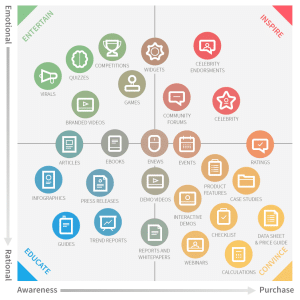Digital Fundraising: Why Content is the Key to Long Term Success
Donations from individual givers are the lifeblood of many charities. They can provide us with a regular and predictable income base that enables us to forecast and plan all those vital projects to support our beneficiaries.
But what does the donor of today want from a charity in return for their continued support? The answer is great content!
What is content marketing?
We hear the terms content marketing and content strategy but what are we talking about?
There are many definitions out there but the Content Marketing Institute gives us one of the best:
‘Content marketing is a strategic marketing approach focused on creating and distributing valuable, relevant, and consistent content to attract and retain a clearly defined audience’.
The concept itself is nothing new. 25+ years ago the main content marketing option for charities was to periodically send out in the post a printed newsletter with lots of great stories, case studies … and probably an appeal for donations, volunteers, etc. These were (and still are!) expensive to produce and deliver, so we felt obliged to try and optimise every precious inch of space!
It’s the vast choice of distribution channels now available to us that has created the great content marketing opportunity. It enables us to cost effectively share content much more regularly and really drive effective donor acquisition, retention and development.
How do I get started?
Start with the target audience! Building a persona for each key audience you are trying to reach enables you to get much closer to them and, more importantly, start to really understand their way of thinking. If this concept is new to you, here’s a great definition from Smart Insights (smartinsights.com):
“A persona is a fictional character that communicates the primary characteristics of a group of users, identified and selected as a key target through use of segmentation data, across the company in a usable and effective manner”.
Begin with the basic ‘who’ information, including:
- Age range
- Location
- Gender
Then try to incorporate thoughts and ideas based around answers to questions like these:
- What really interests them?
- What are they looking for from us?
- Where are they looking for information?
- When are they looking?
- How are we different from other providers out there?
- Why should they support us?
There are some great templates to help you build really effective personas and this one is developed specifically for the sector: https://mediatrust.org/resource-hub/audience-persona-canvas-for-charities/
Great content must add value – to achieve this you need to demonstrate that you really understand the target persona rather than just ‘know’ them.
What topics should I cover?
Rather than thinking of content as a big mass of assets, try to develop a range of ‘content pillars’. These enable you to develop a more structured approach.
You could start with just 3 or 4, for example:
- The organisation: your history, achievements, staff, values, etc.
- Projects: case studies, behind the scenes, meet the team, etc.
- Expertise: research, opinion, forecasting, FAQs, etc.
Once you have your pillars, the content marketing matrix may help you to develop a range of content types. It combines 2 essential aspects. The first is that all the decisions we make are a balance of emotional and rational thinking – that combination of the head and the heart. Which one leads us at any moment in time depends on many things and can vary considerably. The second aspect is that content needs to change and adapt along the supporter journey as potential supporters move from awareness to donation.

(graphic source: https://www.smartinsights.com/content-management/content-marketing-strategy/the-content-marketing-matrix-new-infographic/)
Whilst we can create some of our own content, organisations that have an effective content strategy understand the power of content curation. Content curation means selecting and then sharing content you didn’t create. It could be a link to an article, a roundup of quoted advice from an expert, or simply reposting someone else’s social media post. Reasons to use curated content include:
- Save time and money
- Establish new relationships and develop existing ones
- Diversify your content range
- Develop community engagement potential
- Position yourself as a thought leader
Remember the 4-1-1 rule to help you develop a manageable balance for content publishing:
- 4 pieces of curated content, shared from external sources
- 1 piece of original content, produced by you
- 1 piece of promotional content, aimed at getting donations
This article from Corinna Keefe includes some sound advice on how this can be applied: https://www.easypromosapp.com/blog/en/social-media-content/
So, what types of content should I be considering?
- Social media posts
Obvious, I know, but this can be the most accessible way to share content regularly – the key is to mix up and provide a range. - Videos & photos
Nothing tells a story like impactful visuals and this article provides some great practical advice: https://charitydigital.org.uk/topics/how-to-harness-the-power-of-video-marketing-10513. Genuine, authentic looking photos and images are far more important than gloss and style. - Infographics
Statistics are important to illustrate the problem and showcase the difference you make. Use tools like Canva to turn these into infographics to give impact and shareability. - Blog posts
Including a blog area on your website can provide an easy vehicle for multiple contributors to seize the moment and upload content (copy and images) quickly and easily. These can then be saved for an editor to proofread, optimise and publish. - Research articles & reports
These provide the opportunity to show your depth of understanding and demonstrate change leadership. From these you can create snapshots to promote and draw attention to the subject. - Podcasts:
These continue to grow in popularity and provide a great opportunity to showcase your work in an audible way that can easily be consumed on the move.
What specific benefits might I expect?
- Increases Awareness and Reputation
According to a survey by the Content Marketing Institute, 86% of non-profit marketing professionals believe content marketing is an effective way to raise awareness for their organisation. - Engages Supporters and Builds Community
Developing and sharing relevant and meaningful content can enable you to create a sense of belonging and foster a deeper connection with your supporters. As a result, you receive increased engagement, loyalty and advocacy. - Educates and Inspires Action
Informative and inspiring content can be a powerful tool to educate, inspire and motivate your audience to get more involved. - Improves Donor Retention
Demonstrating the impact of donations by sharing stories and updates about your work can encourage continued support. - Cost-Effective
Content marketing is more affordable than traditional advertising and marketing tactics. According to the Content Marketing Institute, it costs 62% less than traditional marketing and generates more than three times as many leads! - Increases Credibility and Authority
Sharing informative and educational content enables non-profit organisations to demonstrate their knowledge and expertise and position themselves as thought leaders. - Provides Long-Term Benefits
By creating content like blogs and videos, non-profit organisations can continue to attract new supporters and engage existing ones long after its creation, demonstrating great return on investment. - Provides Measurable Results
The ability to track key performance indicators, like website traffic, social media engagement, and email open rates, can help you gauge the effectiveness of your content. Analysing the data can help you make informed decisions about your content strategy so you can adjust your approach as needed. - Increases Website Traffic
Creating and sharing quality content can drive traffic to your website. Increased website traffic can ultimately lead to increased donations and event attendance. It can also inspire more people to volunteer.
Disclaimer:
This article is provided for information purposes only and is general and educational in nature and does not constitute legal advice. The information contained herein should not be considered as a substitute for seeking professional advice in specific circumstances.
All opinions expressed are the individuals own and not of (or to be affiliated with) the Benefact Group plc or its group companies.
Benefact Group plc shall not be liable for your use or any reliance on, or action taken (or not taken) by you and any loss, however incurred, as a result; all responsibility for such is excluded (except for that which cannot be excluded by law) by the Benefact Group plc.
Please note that over time the information contained herein may become out of date and may not constitute best market practice, that it is subject to change and new editions may be issued to incorporate such changes. You acknowledge that Benefact Group plc have no duty to provide such changes to this article..
References:
Keefe, C. (2024) Structure Your Social Media Content with the 4-1-1 Rule
[Online]. Available at: https://www.easypromosapp.com/blog/en/social-media-content/ [Accessed August 2024]
Seiler, R. (2023) Nonprofit Content Marketing Advanced Guide
[Online]. Available at: https://bigsea.co/ideas/nonprofit-content-marketing/
[Accessed August 2024]
McCoy, J. (2022) 7 Content Idea Generators to Help You Ideate Creative Content Consistently
[Online]. Available at: https://contenthacker.com/content-idea-generator/
[Accessed August 2024]
Christison, C. (2024) Content Curation in 2024: Everything You Need To Know
[Online]. Available at: https://blog.hootsuite.com/beginners-guide-to-content-curation/ [Accessed August 2024]
NonProfit Megaphone (2024) Content Marketing for Nonprofits: Why It’s Important
[Online]. Available at: https://nonprofitmegaphone.com/9-reasons-content-marketing-is-important-for-nonprofit-organizations/
[Accessed August 2024]
Chaffey, D. (2024) The Content Marketing Matrix
[Online]. Available at: https://www.smartinsights.com/content-management/content-marketing-strategy/the-content-marketing-matrix-new-infographic/
[Accessed August 2024]
Wessel, M. (2022) How to harness the power of video marketing
[Online]. Available at: https://charitydigital.org.uk/topics/how-to-harness-the-power-of-video-marketing-10513
[Accessed August 2024]

Nick Day BA (Hons), DipDM, DET, MIDM, MCIM
DSC Associate Trainer and Marketing Practitioner, Trainer and Tutor
With over 30 years’ commercial experience, Nick’s expertise spans both traditional and digital marketing. He’s worked with a broad range of commercial and not-for-profit organisations, including British Airways, Sony, Barclays, Virgin Media, Humanists International, Amnesty International and Parkinson’s UK.
As a digital marketer for more than 15 years, Nick delivers effective content and campaigns that utilise all components of the digital toolkit, including Website Design & Development, Search Engine Marketing, Social Media Marketing and Email Marketing.
An experienced tutor, Nick delivers many modules on the Chartered Institute of Marketing (CIM) Certificate and Diploma qualifications in Professional Digital Marketing. He provides virtual and classroom-based marketing training that is always focused on being engaging and providing practical advice and guidance.
